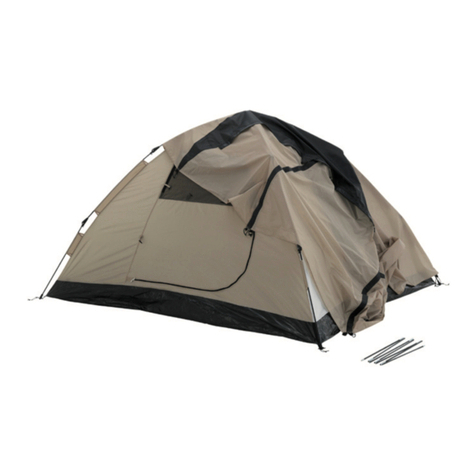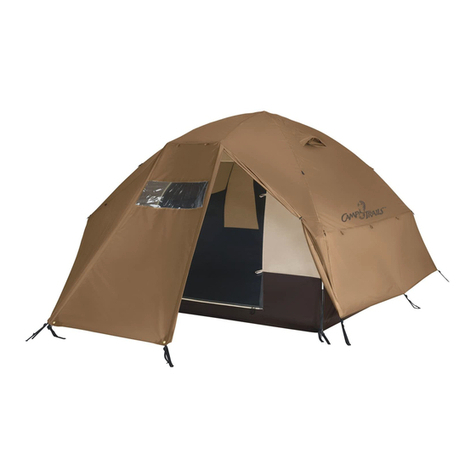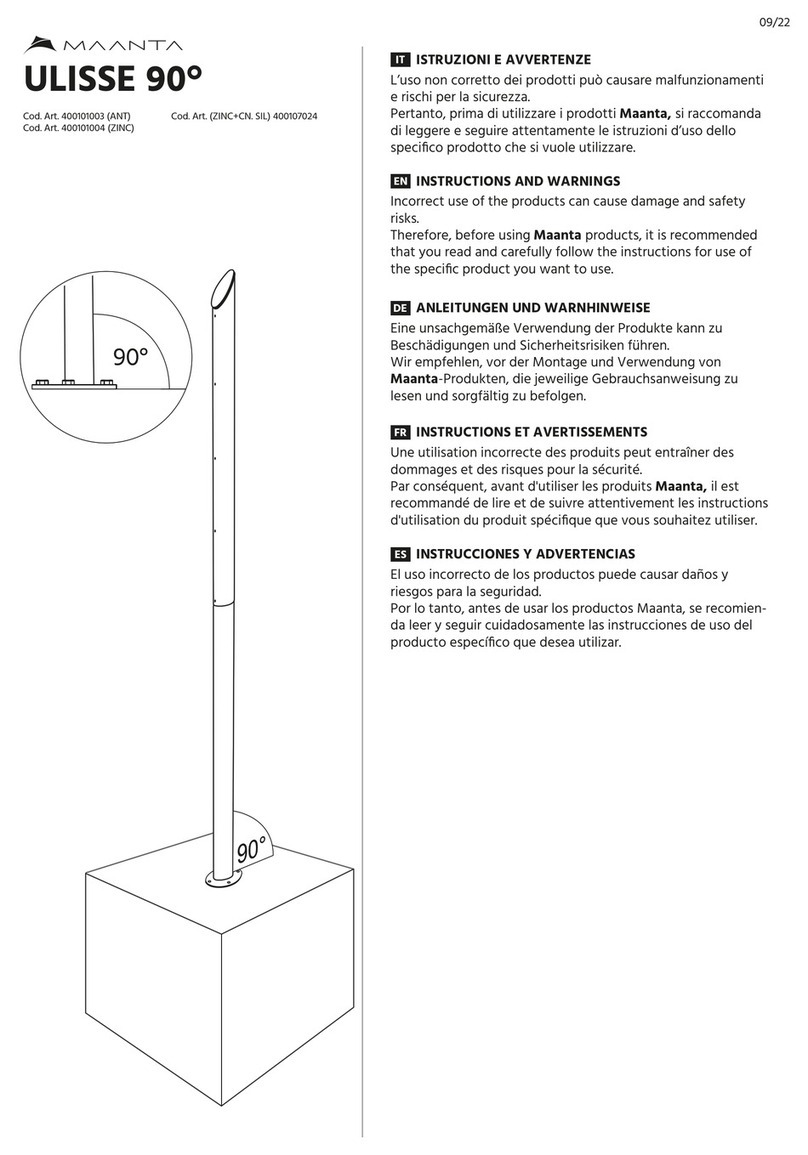
SELECTIVE PROTECTIVE SURFACING
One of the most important things you can do to reduce the likelihood of
serious head injuries is to install shock-absorbing protecve surfacing
under and around your play equipment. The protecve surfacing should be
applied to a depth that is suitable for the equipment height in accordance
with ASTM F1292. There are dierent types of surfacing to choose from;
whichever product you select, follow these guidelines. (See gure 2)
NOTE—Do not install home playground equipment over concrete,
asphalt, or any other hard surface. A fall onto a hard surface can result
in serious injury to the equipment user. Grass and dirt are not considered
protecve surfacing because wear and environmental factors can
reduce their shock absorbing eecveness. Carpeng and thin mats are
generally not adequate protecve surfacing. Ground level equipment
such as a sandbox, acvity wall, playhouse or other equipment that has
no elevated play surface-does not need any protecve surfacing.
LOOSE-FILL MATERIALS
• Maintain a minimum depth of 9 in. of loose-ll materials such as
wood mulch/chips, engineered wood ber (EWF), or shredded/
recycled rubber mulch for equipment up to 96 in. high; and
9 in. of sand or pea gravel for equipment up to 60 in. high.
• NOTE: An inial ll level of 12 in. will compress to about a 9 in.
depth of surfacing over me. The surfacing will also compact,
displace, and sele, and should be periodically relled to maintain
at least a 9 in. depth.
• Use a minimum of 6 in. of protecve surfacing for play
equipment less than 48 in. in height. If maintained properly,
this should be adequate. (At depths less than 6 in., the
protecve material is too easily displaced or compacted.)
• Use containment, such as digging out around the
perimeter and/or lining the perimeter with landscape
edging. Don’t forget to account for water drainage.
• Check and maintain the depth of the loose-ll surfacing material.
To maintain the right amount of loose-ll materials, mark the
correct level on play equipment support posts. That way you can
easily see when to replenish and/or redistribute the surfacing.
• Do not install loose ll surfacing over hard
surfaces such as concrete or asphalt.
POURED-IN-PLACE SURFACES OR PRE-MANUFACTURED RUBBER
TILES: You may be interested in using surfacing other than loose-
ll materials – like rubber les or poured-in-place surfaces.
• Installaons of these surfaces generally require a
professional and are not “do-it-yourself” projects.
• Review surface specicaons before purchasing this type
of surfacing. Ask the installer/ manufacturer for a report
showing that the product has been tested to the following
safety standard: ASTM F1292 Standard Specicaon for Impact
Aenuaon of Surfacing Materials within the Use Zone of
Playground Equipment. This report should show the specic
height for which the surface is intended to protect against
serious head injury. This height should be equal to or greater
than the fall height-vercal distance between a designated
play surface (elevated surface for standing, sing, or climbing)
and the protecve surfacing below-of your play equipment.
• Check the protecve surfacing frequently for wear.
PLACEMENT: Proper placement and maintenance of
protecve surfacing is essenal. Be sure to:
• Extend surfacing at least 72 in. from the
equipment in all direcons.
• For to-and-fro swings, extend protecve surfacing in front
of and behind the swing to a distance equal to twice the
height of the top bar from which the swing is suspended.
• For re swings, extend surfacing in a circle whose
radius is equal to the height of the suspending
chain or rope, plus 6 feet in all direcons.
OPERATION INSTRUCTIONS
• An adult should supervise play on this
product for children of all ages.
• Only for family residenal domesc use.
• Designed for mul-rider use.
• Safety rated to 250 lb.
• Maximum fall height 6.5 . (determined by swing pivot point,
maximum hanging rope length and 24 in. above ground surface).
OPERATION WARNING: Riders should be dressed appropriately including
wearing well-ng shoes that fully protect feet. Remove arcles before
swinging that create hazards when they get tangled and caught (examples
include ponchos, scarves, and other loose-ng clothing, bike or sports
helmets). Adhere to the following guidelines for operaon: Do not swing
the swing higher than hook aachment • Remove rider from the swing
only aer it has completely stopped • Do not twist swing chains or ropes
or loop them over the top support bar since this may reduce the strength
of the chain or rope • Avoid swinging empty seats • Do not walk close to,
in front of, or behind, or between moving items • Rider should sit in center
of the swing with full weight in the seat • Do not use the equipment in
a manner other than intended • Do not aach items to the playground
equipment or support structure that the swing is aached to that are not
specically designed for use with the equipment, such as, but not limited
to, jump ropes, clothesline, pet leashes, cables and chain as they may
cause a strangulaon hazard • Do not climb swing when it is wet • When
the swing is in direct sunlight, check that seang surface is not too hot.
Maintenance Instructions
MAINTENANCE WARNING:Failure to carry out these checks
and inspecons could result in a fall or injury. Owners shall be
responsible for maintaining the legibility of the warning labels.
AT THE BEGINNING OF EACH PLAY SEASON:
• Check all moving parts including swing seat, ropes, cables,
and chains for excessive wear, fractures, breaks, sharp
edges, rust, or other deterioraon. Replace as needed.
• Tighten all hardware.
• Check metal parts for rust. If found, sand and repaint using a
non-lead-based paint meeng the requirements of 16 1303.
• Reinstall any plasc parts, such as swing seat or any
other items that were removed for the cold season.
• Rake and check depth of loose ll protecve surfacing
materials to prevent compacon and to maintain
appropriate depth. Replace as necessary.
(2) TWICE A MONTH DURING PLAY SEASON:
• Tighten all hardware.
• Rake and check depth of loose ll protecve surfacing
materials to prevent compacon and to maintain
appropriate depth. Replace as necessary.
• Check all moving parts including swing seats,
ropes, cables, and chains for wear, rust, or other deterioraon.
Replace as needed.
AT THE END OF EACH PLAY SEASON OR WHEN
THE TEMPERATURE DROPS BELOW 32°F:
• Remove plasc swing seat and other items
and take indoors or do not use.
• Rake and check depth of loose ll protecve surfacing
materials to prevent compacon and to maintain
appropriate depth. Replace as necessary.
SWING DISPOSAL: When you are ready to dispose of swing, make sure
that all swing components are disposed of in accordance with local waste
ordinances. Swing should be disassembled and disposed of in such a way
that no unreasonable hazards exist at the me the swing is discarded.
SAFETY INFORMATION: To reduce the likelihood of injury please follow the
guidelines as outlined in this instrucon manual. You can visit our website
www.mandmsalesinc.com to review the instrucon manual in the future
or keep this instrucon sheet for reference: MM00175 Teepee Tent Swing
Instrucon Manual. The installaon instrucons above are reecve of the U.S.
Consumer Product Safety Commission’s Outdoor Playground Safety Handbook.
For a complete descripon of installaon instrucons and warnings for outdoor
playground equipment you can visit our website www.mandmsalesinc.
com to link to the current CPSC handbook and review in its enrety.
Our products are tested to ensure safety and compliance with
Consumer Product Safety Improvement Act of 2008 (CPSIA) including
specicaons for lead paint and phthalates and ASTM Internaonal
F1148 Standard Consumer Safety Performance Specicaons.
CALIFORNIA PROPOSITION 65 WARNING: THIS PRODUCT CONTAINS CHEMICALS KNOWN TO THE STATE
OF CALIFORNIA TO CAUSE CANCER AND BIRTH DEFECTS OR OTHER REPRODUCTIVE HARM.
M&M Sales Enterprises, Inc.
1300 Synergy Ct, Dubuque, IA 52002 877-242-0514
www.mandmsalesinc.com
Figure 2



















